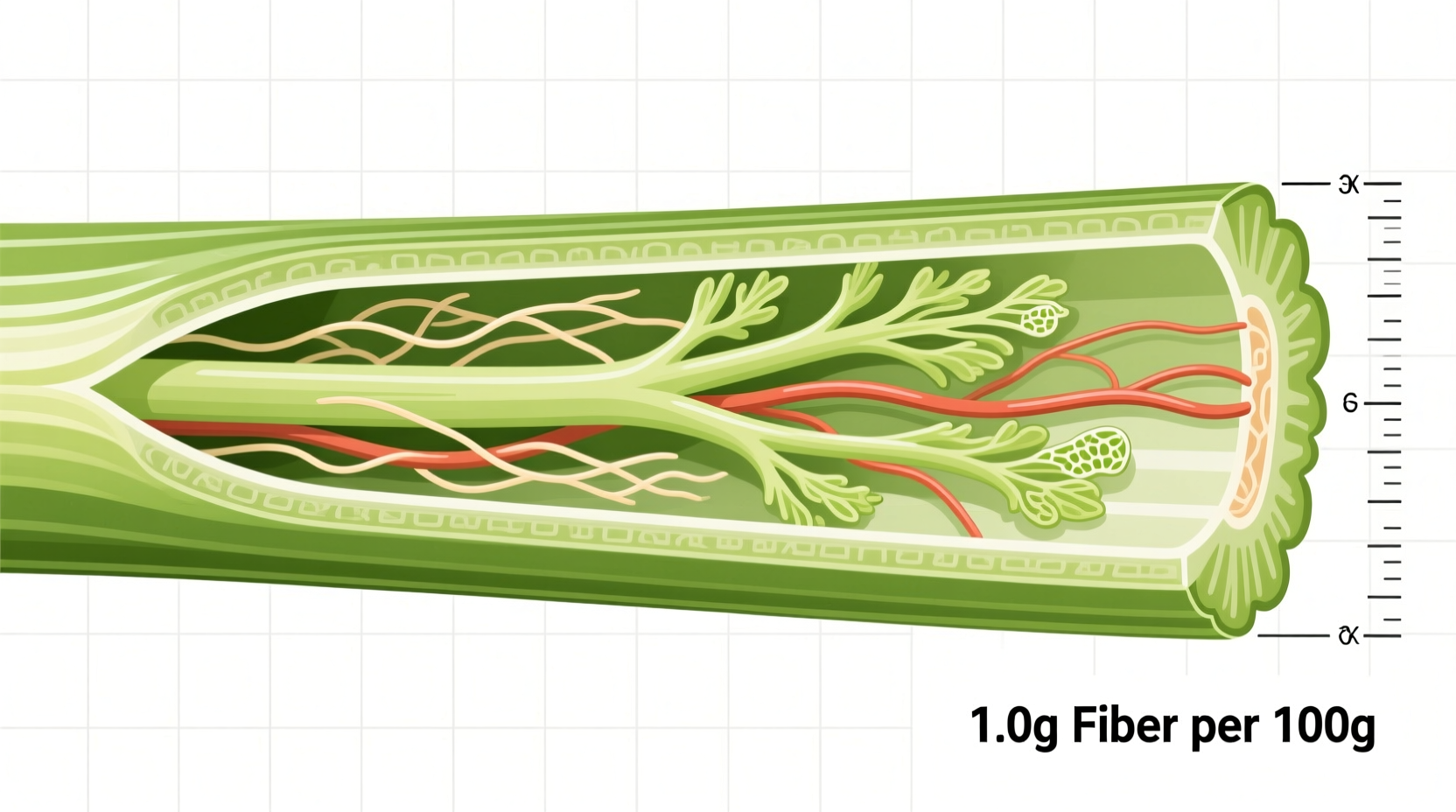When you're tracking your daily fiber intake, knowing exactly how much fiber is in celery helps you make informed dietary choices. While celery isn't the highest-fiber vegetable available, its unique combination of hydration, crunch, and moderate fiber content makes it a versatile component of balanced nutrition.
Understanding Celery's Fiber Content
Celery's fiber content might surprise you—many people assume this watery vegetable offers minimal nutritional value. However, research from the USDA FoodData Central reveals that celery delivers meaningful fiber in every crisp bite. The fiber in celery primarily comes from its stringy vascular bundles, which many people discard but actually contain concentrated dietary fiber.
| Celery Serving Size | Dietary Fiber | Percent of Daily Value* |
|---|---|---|
| 1 medium stalk (40g) | 0.6g | 2% |
| 1 cup chopped (101g) | 1.6g | 6% |
| 2 cups chopped (202g) | 3.2g | 11% |
| 1 cup celery juice (240ml) | 0.4g | 1% |
*Based on a 25g daily fiber recommendation for adults. Individual needs vary based on age, gender, and caloric intake.
How Celery Compares to Other Vegetables
While celery provides moderate fiber, understanding how it stacks up against other common vegetables helps you optimize your high-fiber diet. According to data from the Harvard T.H. Chan School of Public Health, here's how celery compares:
- Broccoli (1 cup): 5.1g fiber - more than triple celery's content
- Carrots (1 cup): 3.6g fiber - over twice as much as celery
- Cucumbers (1 cup): 0.9g fiber - slightly less than celery
- Green beans (1 cup): 4.0g fiber - significantly higher than celery
This comparison reveals celery's context boundaries—it's not your best option when maximizing fiber intake is the primary goal, but it shines when you need a low-calorie, hydrating snack that still contributes meaningful fiber. For those managing blood sugar levels, celery's combination of fiber and low glycemic impact makes it particularly valuable.

Maximizing Fiber Benefits from Celery
To get the most fiber from celery, follow these evidence-based strategies:
Eat the Strings, Not Just the Stalk
Those fibrous strings running along celery stalks contain concentrated dietary fiber. When you remove them, you're discarding some of celery's most valuable fiber content. Instead of peeling celery, simply wash thoroughly and eat whole for maximum fiber benefit.
Pair with High-Fiber Dips
Combine celery's modest fiber with high-fiber dips to create a substantial snack:
- Hummus (2 tbsp provides 2g fiber)
- Guacamole with beans (¼ cup provides 4g fiber)
- Almond butter (1 tbsp provides 1.6g fiber)
Incorporate Into High-Fiber Meals
Add chopped celery to dishes where its fiber compounds with other high-fiber ingredients:
- Stir-fries with brown rice and broccoli
- Bean salads with kidney beans and chickpeas
- Whole grain stuffings with oats or quinoa
Celery's Role in a Balanced High-Fiber Diet
While celery alone won't meet your daily fiber needs, it plays a strategic role in comprehensive fiber strategies. The Mayo Clinic recommends adults consume 25-38 grams of fiber daily, depending on age and gender. Celery contributes to this goal while providing additional benefits:
- Hydration support: 95% water content complements fiber's water-absorbing properties
- Digestive synergy: Contains both soluble and insoluble fiber types
- Low-calorie density: Only 16 calories per cup, making it ideal for weight management
- Nutrient pairing: Enhances absorption of fat-soluble vitamins when eaten with healthy fats
For individuals with digestive sensitivities, celery's moderate fiber content makes it a gentler introduction to high-fiber eating compared to more fibrous vegetables. Its natural electrolytes also help prevent the bloating that sometimes accompanies rapid increases in fiber consumption.
Practical Applications for Different Dietary Goals
Understanding how much fiber is in celery helps tailor its use to specific health objectives:
For Weight Management
The combination of low calories and moderate fiber creates high satiety. One study published in the Journal of Nutrition found that crunchy, high-water vegetables like celery increase chewing time, which enhances feelings of fullness and reduces overall calorie intake.
For Blood Sugar Control
Celery's fiber content slows glucose absorption. Research from the American Diabetes Association shows that adding moderate-fiber vegetables like celery to meals can reduce post-meal blood sugar spikes by up to 20% compared to low-fiber alternatives.
For Digestive Health
While not as potent as some high-fiber vegetables, celery's combination of fiber types supports both regularity and gut microbiome diversity. The insoluble fiber adds bulk to stool, while soluble fiber feeds beneficial gut bacteria.
Common Misconceptions About Celery Fiber
Several myths persist about celery's nutritional value:
- "Celery has negative calories" - While celery is very low calorie, the thermic effect of food doesn't actually create negative calories
- "Celery juice removes all fiber" - True, but whole celery retains all its fiber benefits
- "Only the strings contain fiber" - Fiber is distributed throughout the stalk, though concentrated in the strings
These misconceptions often lead people to undervalue celery's genuine nutritional contributions. When consumed properly, celery delivers measurable fiber benefits that support overall health.











 浙公网安备
33010002000092号
浙公网安备
33010002000092号 浙B2-20120091-4
浙B2-20120091-4